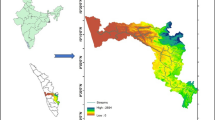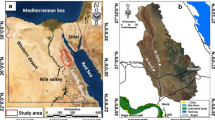Abstract
Floods are a hazard for artificial structures and humans. From natural hazard management point of view, present the new techniques to assess the flood susceptibility is considerably important. The aim of this research is on one hand to evaluate applicability of different machine learning and advanced techniques (MLTs) for flood susceptibility analysis and on the other hand to investigate of the contribution of geo-environmental factors to flood inundation in a semi-arid part of SW Iran. Here, we compare the performance of six modeling techniques namely random forest (RF), maximum entropy (ME), multivariate adaptive regression splines (MARS), general linear model (GLM), generalized additive model (GAM), and classification and regression tree (CART)for first time to spatial predict the flood prone-area at Tashan Watershed, southwestern Iran. In the first step of study, a flood inventory map with 169 flood events was constructed through field surveys. These flood locations were then spatially randomly split into train, and validation sets with two different proportions of ratio 70 and 30%. Ten flood conditioning factors such as landuse, lithology, drainage density, distance from roads, topographic wetness index (TWI), slope aspect, distance from rivers, slope angle, plan curvature and altitude were considered in the analysis. In addition, learning vector quantization (LVQ) was used as a new supervised neural network algorithm to analyse thevariable importance. The applied models were evaluated for performance appliyng the area under the receiver operating characteristic curve (AUC). The result demonstrated that CART had the AUC value of 93.96%. It was followed by ME (88.58%), RF (86.81%), GAM (81.35%), MARS (75.62%), and GLM (73.66%).
Access this chapter
Tax calculation will be finalised at checkout
Purchases are for personal use only
Similar content being viewed by others
References
Agresti A (1996) An introduction to categorical data analysis. Wiley, New York
Ayalew L, Yamagishi H, Ugawa N (2004) Landslide susceptibility mapping using GIS-based weighted linear combination, the case in Tsugawa area of Agano River, Niigata Prefecture. Japan. Landslides 1(1):73–81
Beven KJ, Kirkby MJ (1979) A physically based, variable contributing area model of basin hydrology/Un modèle à base physique de zone d’appel variable de l’hydrologie du bassin versant. Hydrolog Sci Bull 24(1):43–69
Breiman L (2001) Random forests. Mach Learn 45:5–32
Breiman L, Friedman JH, Olshen RA, Stone CJ (1984) Classification and regression trees. Wadsworth, Belmont, CA
Brenning A (2008) Statistical geocomputing combining R and SAGA: the example of landslide susceptibility analysis with generalized additive models. In: Böhner J, Blaschke T, Montanarella L (eds) SAGA—seconds out (=Hamburger Beiträge zur Physischen Geographie und Landschaftsökologie, 19), pp 23–32
Brenning A (2009) Benchmarking classifiers to optimally integrate terrain analysis and multispectral remote sensing in automatic rock glacier detection. Remote Sens Environ 113(1):239–247
Cherqui F, Belmeziti A, Granger D, Sourdril A, Gauffre PL (2015) Assessing urban potential flooding risk and identifying effective risk-reduction measures. Sci Total Environ 514:418–425
Crawley MJ (1993) GLIM for ecologists. Blackwell Scientific Publications, Oxford
Cutler DR, Edwards TC, Beard KH, Cutler A, Hess KT, Gibson J, Lawler JJ (2007) Random forests for classification in ecology. Ecology 88(11):2783–2792
Devkota KC, Regmi AD, Pourghasemi HR, Yoshida K, Pradhan B, Ryu IC, Dhital MR, Althuwaynee OF (2013) Landslide susceptibility mapping using certainty factor, index of entropy and logistic regression models in GIS and their comparison at Mugling-Narayanghat road section in Nepal Himalaya. Nat Hazards 65:135–165
Felicísimo Á, Cuartero A, Remondo J, Quirós E (2013) Mapping landslide susceptibility with logistic regression, multiple adaptive regression splines, classification and regression trees, and maximum entropy methods: a comparative study. Landslides 10:175–189
Friedman JH (1991) Multivariate adaptive regression splines. Ann Stat 19:1–141
Geology Survey of Iran (GSI) (1997) http://www.gsi.ir/Main/Lang_en/index.html
Goetz JN, Guthrie RH, Brenning A (2011) Integrating physical and empirical landslide susceptibility models using generalized additive models. Geomorphology 129:376–386
Graham CH, Elith J, Hijmans RJ, Guisan A, Peterson AT, Loiselle BA The NCEAS predicting Species Distributions Working Group (2008) The influence of spatial errors in species occurrence data used in distribution models. J Appl Ecol 45:239–247
Hastie TJ, Tibshirani RJ (1990) Generalized additive models, 2nd edn. Chapman and Hall, London
Hastie T, Tibshirani R, Friedman J (2001) The elements of statistical learning: data mining, inference, and prediction. Springer, New York
Iranian meteorological organization (IMO) (2014) http://www.irimo.ir/eng/index.php
Jebur MN, Pradhan B, Tehrany MS (2013) Using ALOS PALSAR derived high- resolution DInSAR to detect slow-moving landslides in tropical forest: Cameron Highlands, Malaysia. Geomatics Nat Hazards Risk 6(8):1–19
Kazakis N, Kougias I, Patsialis T (2015) Assessment of flood hazard areas at a regional scale using an index-based approach and analytical hierarchy process: application in Rhodope-Evros region, Greece. Sci Total Environ 538:555–563
Kia MB, Pirasteh S, Pradhan B, Mahmud AR, Sulaiman WNA, Moradi A (2012) An artificial neural network model for flood simulation using GIS: Johor River Basin, Malaysia. Environ Earth Sci 67:251–264
Kohonen T (1995) Learning vector quantization; self-organizing maps. Springer, Berlin, pp 175–189
Kurt I, Ture M, Kurum AT (2008) Comparing performances of logistic regression, classification and regression tree, and neural networks for predicting coronary artery disease. Expert Syst Appl 34(1):366–374
Lee S, Pradhan B (2007) Landslide hazard mapping at Selangor, Malaysia using frequency ratio and logistic regression models. Landslides 4:33–41
Lee MJ, Kang JE, Jeon S (2012) Application of frequency ratio model and validation for predictive flooded area susceptibility mapping using GIS. In: 2012 IEEE international geoscience and remote sensing symposium, pp 895–898
Liu C, White M, Newell G, Griffioen P (2013) Species distribution modelling for conservation planning in Victoria, Australia. Ecol Model 249:68–74
Liu X, Li N, Yuan S, Xu N, Shi W, Chen W (2015) The joint return period analysis of natural disasters based on monitoring and statistical modeling of multidimensional hazard factors. Sci Total Environ 538:724–732
Lohani A, Kumar R, Singh R (2012) Hydrological time series modeling: a comparison between adaptive neuro-fuzzy, neural network and autoregressive techniques. J Hydrol 442:23–35
Lumbroso D, Stone K, Vinet F (2011) An assessment of flood emergency plans in England and Wales, France, and the Netherlands. Nat Hazards 58:341–363
Mustafa D, Gioli G, Qazi S, Waraich R, Rehman A, Zahoor R (2015) Gendering flood early warning systems: the case of Pakistan. Environ Hazards 14(4):312–328
Naghibi A, Pourghasemi HR (2015) A comparative assessment between three machine learning models and their performance comparison by bivariate and multivariate statistical methods for groundwater potential mapping in Iran. Water Resour Manag 29:5217–5236
Oh HJ, Pradhan B (2011) Application of a neuro-fuzzy model to landslide-susceptibility mapping for shallow landslides in a tropical hilly area. Comput Geosci 37:1264–1276
Ohlmacher GC, Davis JC (2003) Using multiple logistic regression and GIS technology to predict landslide hazard in northeast Kansas, USA. Eng Geol 69:331–343
Ozdemir A, Altural T (2013) A comparative study of frequency ratio, weights of evidence and logistic regression methods for landslide susceptibility mapping: Sultan Mountains, SW Turkey. J Asian Earth Sci 64:180–197
Peters J, Baets BD, Verhoest NEC, Samson R, Degroeve S, Becker PD, Huybrechts WH (2007) Random forests as a tool for ecohydrological distribution modelling. Ecol Model 207:304–318
Phillips S, Dudík M, Schapire R (2004) A maximum entropy approach to species distribution modeling. In: Proceedings of the 21th International conference on machine learning. Association for Computing Machinery (ACM), Banff, Canada
Phillips S, Anderson R, Schapire R (2006) Maximum entropy modelling of species geographic distributions. Ecol Model 190:231–259
Pourghasemi HR, Pradhan B, Gokceoglu C (2012) Application of fuzzy logic and analytical hierarchy process (AHP) to landslide susceptibility mapping at Haraz watershed, Iran. Nat Hazards 63:965–996
Pourghasemi HR, Goli Jirandeh A, Pradhan B, Xu C, Gokceoglu C (2013) Landslide susceptibility mapping using support vector machine and GIS at the Golestan Province, Iran. J Earth Sys Sci 122(2):349–369
Pradhan B (2009) Flood susceptible mapping and risk area delineation using logistic regression, GIS and remote sensing. J Spatial Hydrol 9(2):1–18
Pradhan B, Youssef AM (2011) A100-year maximum floood susceptibility mapping using integrated hydrological and hydrodynamic models: Kelantan River Corridor, Malaysia. J Flood Risk Manage 4(3):189–202
R Development Core Team (2015) R: a language and environment for statistical computing. R Foundation for Statistical Computing, Vienna
Rahmati O, Pourghasemi HR, Zeinivand H (2015a) Flood susceptibility mapping using frequency ratio and weights-of-evidence models in the Golastan Province, Iran. Geocarto Int. https://doi.org/10.1080/10106049.2015.1041559
Rahmati O, Zeinivand H, Besharat M (2015b) Flood hazard zoning in Yasooj region, Iran, using GIS and multi-criteria decision analysis, Geomatics. Nat Hazards & Risk. https://doi.org/10.1080/19475705.2015.1045043
Rahmati O, Pourghasemi HR, Melesse AM (2016) Application of GIS-based data driven random forest and maximum entropy models for groundwater potential mapping: a case study at Mehran Region, Iran. Catena 137:360–372
Suzen ML, Doyuran V (2004) A comparison of the GIS based landslide susceptibility assessment methods: multivariate versus bivariate. Environ Geol 45:665–679
Tehrany M, Pradhan B, Jebur MN (2013) Spatial prediction of flood susceptible areas using rule based decision tree (DT) and a novel ensemble bivariate and multivariate statistical models in GIS. J Hydrol 504:69–79
Tehrany M, Lee MJ, Pradhan B, Jebur MN, Lee S (2014a) Flood susceptibility mapping using integrated bivariate and multivariate statistical models. Environ Earth Sci 72:4001–4015
Tehrany M, Pradhan B, Jebur MN (2014b) Flood susceptibility mapping using a novel ensemble weights-of-evidence and support vector machine models in GIS. J Hydrol 512:332–343
Tehrany MS, Pradhan B, Jebur MN (2015a) Flood susceptibility analysis and its verification using a novel ensemble support vector machine and frequency ratio method. Stoch Environ Res Risk Assess. https://doi.org/10.1007/s00477-015-1021-9
Tehrany MS, Pradhan B, Mansor S, Ahmad N (2015b) Flood susceptibility assessment using GIS-based support vector machine model with different kernel types. CATENA 125:91–101
Tien Bui D, Pradhan B, Lofman O, Revhaug I, Dick OB (2012) Spatial prediction of landslide hazards in Hoa Binh province (Vietnam): a comparative assessment of the efficacy of evidential belief functions and fuzzy logic models. CATENA 96:28–40
Tien Bui D, Tuan TA, Klempe H, Pradhan B, Revhaug I (2015) Spatial prediction models for shallow landslide hazards: a comparative assessment of the efficacy of support vector machines, artificial neural networks, kernel logistic regression, and logistic model tree. Landslides. https://doi.org/10.1007/s10346-015-0557-6
Trigila A, Iadanza C, Esposito C, Scarascia-Mugnozza G (2015) Comparison of logistic regression and random forests techniques for shallow landslide susceptibility assessment in Giampilieri (NE Sicily, Italy). Geomorphology 249:119–136
Vorpahl P, Elsenbeer H, Marker M, Schroder B (2012) How can statistical models help to determine driving factors of landslides? Ecol Model 239:27–39
Witten IH, Frank E, Mark AH (2011) Data mining: practical machine learning tools and techniques, 3rd edn. Morgan Kaufmann, Burlington, USA
Yesilnacar EK (2005) The application of computational intelligence to landslide susceptibility mapping in Turkey [PhD thesis]. Department of Geomatics the University of Melbourne, Melbourne, p 423
Youssef AM, Pourghasemi HR, Pourtaghi ZS, Al-Katheeri MM (2015) Landslide susceptibility mapping using random forest, boosted regression tree, classification and regression tree, and general linear models and comparison of their performance at Wadi Tayyah Basin, Landslides, Asir Region, Saudi Arabia. Springer, Berlin. https://doi.org/10.1007/s10346-015-0614-1
Author information
Authors and Affiliations
Corresponding author
Editor information
Editors and Affiliations
Rights and permissions
Copyright information
© 2019 Springer Nature Switzerland AG
About this chapter
Cite this chapter
Davoudi Moghaddam, D., Pourghasemi, H.R., Rahmati, O. (2019). Assessment of the Contribution of Geo-environmental Factors to Flood Inundation in a Semi-arid Region of SW Iran: Comparison of Different Advanced Modeling Approaches. In: Pourghasemi, H., Rossi, M. (eds) Natural Hazards GIS-Based Spatial Modeling Using Data Mining Techniques. Advances in Natural and Technological Hazards Research, vol 48. Springer, Cham. https://doi.org/10.1007/978-3-319-73383-8_3
Download citation
DOI: https://doi.org/10.1007/978-3-319-73383-8_3
Published:
Publisher Name: Springer, Cham
Print ISBN: 978-3-319-73382-1
Online ISBN: 978-3-319-73383-8
eBook Packages: Earth and Environmental ScienceEarth and Environmental Science (R0)




